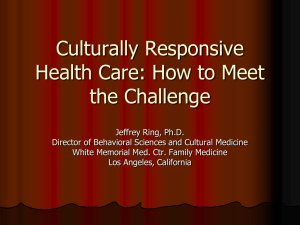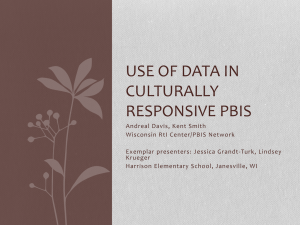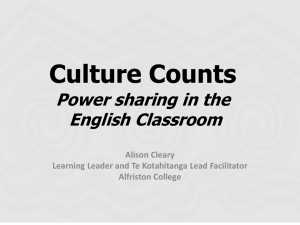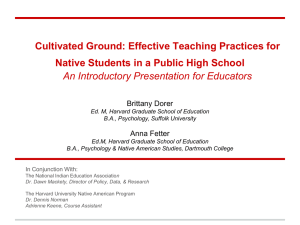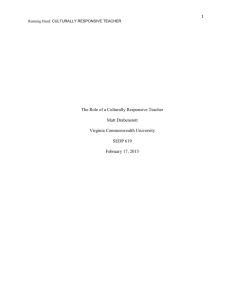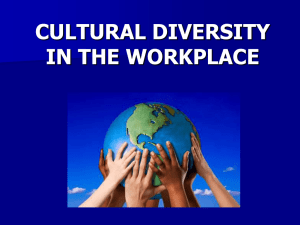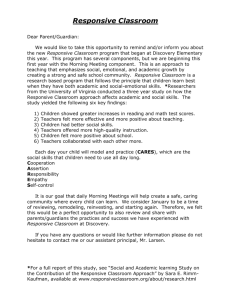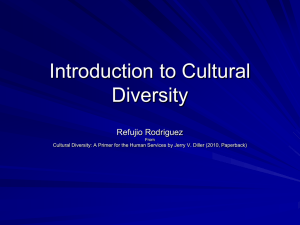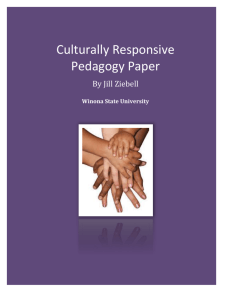On Culturally Responsive Practice
advertisement
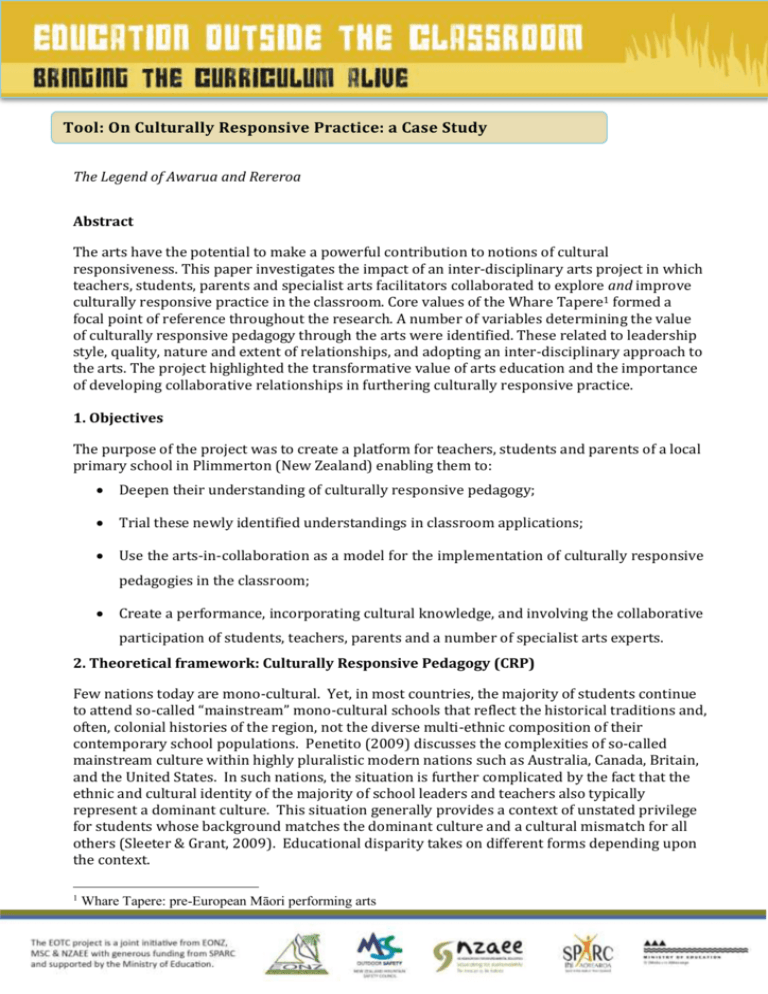
Tool: On Culturally Responsive Practice: a Case Study The Legend of Awarua and Rereroa Abstract The arts have the potential to make a powerful contribution to notions of cultural responsiveness. This paper investigates the impact of an inter-disciplinary arts project in which teachers, students, parents and specialist arts facilitators collaborated to explore and improve culturally responsive practice in the classroom. Core values of the Whare Tapere1 formed a focal point of reference throughout the research. A number of variables determining the value of culturally responsive pedagogy through the arts were identified. These related to leadership style, quality, nature and extent of relationships, and adopting an inter-disciplinary approach to the arts. The project highlighted the transformative value of arts education and the importance of developing collaborative relationships in furthering culturally responsive practice. 1. Objectives The purpose of the project was to create a platform for teachers, students and parents of a local primary school in Plimmerton (New Zealand) enabling them to: Deepen their understanding of culturally responsive pedagogy; Trial these newly identified understandings in classroom applications; Use the arts-in-collaboration as a model for the implementation of culturally responsive pedagogies in the classroom; Create a performance, incorporating cultural knowledge, and involving the collaborative participation of students, teachers, parents and a number of specialist arts experts. 2. Theoretical framework: Culturally Responsive Pedagogy (CRP) Few nations today are mono-cultural. Yet, in most countries, the majority of students continue to attend so-called “mainstream” mono-cultural schools that reflect the historical traditions and, often, colonial histories of the region, not the diverse multi-ethnic composition of their contemporary school populations. Penetito (2009) discusses the complexities of so-called mainstream culture within highly pluralistic modern nations such as Australia, Canada, Britain, and the United States. In such nations, the situation is further complicated by the fact that the ethnic and cultural identity of the majority of school leaders and teachers also typically represent a dominant culture. This situation generally provides a context of unstated privilege for students whose background matches the dominant culture and a cultural mismatch for all others (Sleeter & Grant, 2009). Educational disparity takes on different forms depending upon the context. 1 Whare Tapere: pre-European Māori performing arts How do teachers develop the skills to mediate their pedagogy within today’s schools for students whose culture is not privileged in their schools? This is a crucial issue for teachers who are themselves members of the dominant culture of the school and whose background and teacher education may not have equipped them adequately with cultural knowledge and understandings beyond their own life histories. According to Ginsberg (2005), cultural inclusion is established in our classrooms by using values and practices that contribute to a learning environment in which students and teachers feel respected and connected to one another. And Turinui (2004) recommends that strategies, such as establishing a safe, respectful learning environment, knowing the students and developing meaningful relationships with them, co-constructing the curriculum based on their interests, aspirations and goals, facilitating reciprocal learning amongst classmates, and positively reinforcing good work will contribute to a culturally responsive, multi-level classroom. Culturally responsive pedagogies through the arts Anderson (1996) asserts that the “nature of the arts and their relationship to culture are foundational to their importance in multicultural education” (p. 57). In her comprehensive review of trends in arts education Gadsen (2008) describes a number of major epistemological issues in the arts, such as “the arts as cultural knowledge” (p. 43), and the potential of the arts to engage youth through popular culture that can cross class, race, and gender. She points out that, despite a steady increase in conceptual and theoretical discussions of the place of the arts in schooling and curricula, “...the body of empirical research on the arts is relatively small” (p. 34). Most of the academic literature in the field of arts education continues to comprise descriptions, recommendations, and guidelines, rather than empirical work. 3. Mode of Inquiry: Performative Research This research project employed a Performative Research mode of inquiry setting out to explore and influence culturally responsive practice through the arts. Haseman (2006) presents a compelling argument to acknowledge Performative Research as an autonomous third research paradigm, a methodology with its own approaches to designing, conducting and reporting research, distinct from Quantitative and Qualitative Research. He claims that we are at a pivotal moment in the development of research in which “the approved approaches [of Qualitative and Quantitative research] fail to meet the needs of an increasing number of practice-led researchers, especially in the arts, media and design” (p. 99). The Performative Research paradigm heralds a radical shift from research on practice (practice as an object of study) to practice as (a method of) research. A central aspect to the world of practice is, according to Schön (1983), a sense of “complexity, uncertainty, instability, uniqueness and value conflicts” (p. 14). Performative Research strategies include: the artist journal (embracing reflection-in-action and reflection-on-action); participant research; participatory research; collaborative inquiry; and action research. Haseman (2006) asserts that such strategies reinterpret the aim and scope of academic research: Rather than contribute to the intellectual or conceptual architecture of a discipline, these research enterprises are concerned with the improvement of practice, and new epistemologies of practice distilled from the insider’s understandings of action in context (p. 100, our italics). 4. Indigenous Perspectives: Core Values of the Whare Tapere Throughout the research the core values of the Whare Tapere were used as a focal point of reference. Royal (1998) identifies these values as: manaakitanga, rangatiratanga, whanaungatanga, tohungatanga, ūkaipō, and kotahitanga (pp. 215-216). See the supporting document ‘Te Whare Tapere’ for a further explanation of these six values. 5. Project Overview (Data Sources) The fieldwork took place over a five month period (August – December 2010). Initially a number of staff sessions were held, focusing on CRP literature reviews, practical workshops relating to Māori contexts for learning in the arts, and the collaborative planning of an arts intensive week. It was agreed to use the legend of Awarua (a local taniwha2) and Rereroa (the albatross) as the point of departure for a devised performance. The story relates how Awarua asks Rereroa to teach him how to fly, and during his efforts crashes into the land, creating some of the geographic features of the area. During the art intensive five arts facilitators ran specialist workshops with teachers, students and parents with the following topics: Creating bird masks and costumes; Creating soundscapes for different moments in the story; Creating movement and dance; Visual arts and actions – making masks for taniwha/albatross, creating the bodies for the taniwha/albatross and creating the actions for the taniwha/albatross; 2 Devising theatre for different aspects of the story. Taniwha: mythical creature often the guardian of a harbour, river or lake. While the five-year-old students worked as one group with a dance facilitator, the other students (aged 6 to 12) were able to participate in the workshop of their choice. This led to the formation of groups from different classrooms and ranging in age. On the last day of the art intensive week the students performed their work to the parents and caregivers. The initial plan was to perform the work in the natural environment among the geographic features explained in the story, but bad weather forced a change of plan, and ultimately the performance was relocated to the school grounds. During the entire project, teachers and researchers kept journals and recorded new understandings, insights, lived experiences, highlights, critical incidents, and implications to practice with regards to being culturally responsive. At the conclusion of the project the researchers conducted interviews with the principal, teachers, some of the parents, and some of the students. The journal entries and interviews were transcribed and the transcriptions were analysed, identifying five critical factors that influenced the quality of culturally responsive pedagogy using arts in collaboration. 6. Conclusions At the end of the project the teachers articulated the following discoveries: The arts provide effective tools to explore and express cultural identity and diversity; Culture relates to the values, protocols and rituals of a certain group or community; it is not just about ethnicity, or the use of different greetings/languages in the classroom; To work in groups across ages, and with the school as a whole, creates a fertile ground for the development of leadership and cooperation skills. It also encourages understanding and appreciation of our differences. Space for culturally responsiveness is created through an emphasis on process rather than product (this involved: a flexible use of time; students’ contributions to inform outcomes in unexpected ways; a shared joy and excitement of discovery between teachers, students and parents). Culture is about developing relationships (with students, parents, colleagues, and the wider community). Collaboration is a powerful tool to develop mutual respect, a sense of relatedness (whanaungatanga), shared leadership (rangatiratanga) and an appreciation of our differences and uniqueness. To value culturally responsiveness is to empower the children, teachers, parents and school community as a whole. Through analysis of the entire spectrum of research data (journals, interviews and researchers’ reflection-in-action and reflection-on-action), five variables were identified that significantly impacted the quality and extent of culturally responsive practice through the arts: 1. Taking on a collaborative leadership style; 2. Quality, nature and extent of relationships between teachers, students, parents and the wider community; 3. Adopting inter-disciplinary and collaborative (devising) approaches to the arts as part of the creative development; 4. Working in group formations across age; 5. Exploring and incorporating cultural knowledge as part of the creative process. Students, teachers and parents mentioned on several occasions that working alongside one another in the workshops – exploring unchartered territory and learning new skills – gave rise to a sense of understanding, compassion, mutuality and equality in their relationships that was not experienced before. This cultivated the ground for the values of manaakitanga, whanaungatanga and ūkaipō to emerge strongly. “With confidence, self-esteem, a sense of identity and [self] worth comes academic growth. This is built on the corner stones and foundations of cultural identity. If you don’t have this, you won’t achieve your potential. As teachers we must ensure the emotional and cultural essence of our children is fostered and developed. The roots must be strong for a flower to bloom.” “I understand this now. It is [not only] about knowing and understanding some information about the culture in your classroom, but it is truly about being it, letting the children experience, develop, explore, understand, value and love being who they are. [Encourage them to] express their culture out loud & being affirmed – from others, but essentially from themselves. Get away from the traditional ‘ lets read a book about [...]’ But get out there and feel it/do it/love it. Use the voice, the body, the spirit, the essence” Quotes from teacher interviews, 2010 7. Scholarly Significance There is a dearth of empirical evidence regarding culturally responsive practices in the classroom. In an effort to fill this gap in current literature, this research investigates experiential views on what embodies culturally responsive practice, acknowledging and valuing the teacher’s voice. The participatory nature of this research has empowered teachers to take actions based on lived experiences and gained understandings in relation to the investigated phenomena. References Anderson, T. (1996). The national standards for arts education: A (multi)cultural assessment. Studies in Art Education, 38(1), 55-60. Bishop, R., & Glynn, T. (1999). Culture counts: Changing power relations in education. Palmerston North, New Zealand: Dunmore Press. Gadsen, V. L. (2008). The arts and education: Knowledge generation, pedagogy, and the discourse of learning. Review of Research in Education, 32, 29-61. Ginsberg, M. (2005). Cultural diversity, motivation, and differentiation. Theory into Practice, 44(3), 218-223. Haseman, B. (2006). A manifesto for performative research. Media International Australia Incorporating Culture and Policy, 118, 98-106. Penetito, W. (2009). The struggle to educate the Māori in New Zealand. In J. A. Banks (Ed.), The Routledge international companion to multicultural education (pp. 288-300). New York: Routledge. Royal, T. A. C. (1998). Te Whare Tapere: Towards a model for Māori art. Wellington: Victoria University of Wellington. Schön, D. A. (1983). The reflective practitioner: How professionals think in action. New York: Basic Books. Sleeter, C. E., & Grant, C. A. (2009). Making choices for multicultural education: Five approaches to race, class, and gender (6th ed.). Hoboken, NJ: Wiley. Turinui, H. (2004). Year two of teaching: Not what I’d planned. Teachers and Curriculum Kaiako Me Te Marautanga, 7, 67-73.

